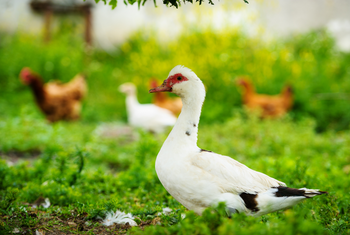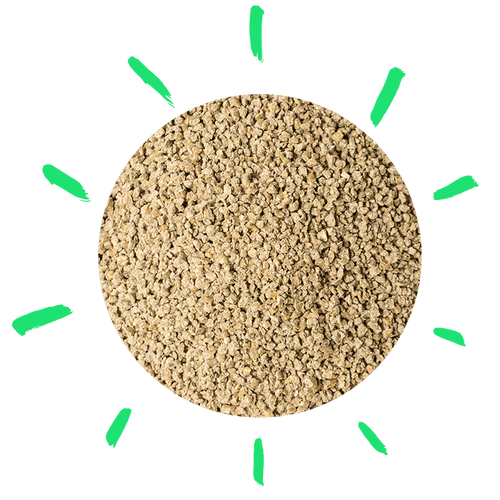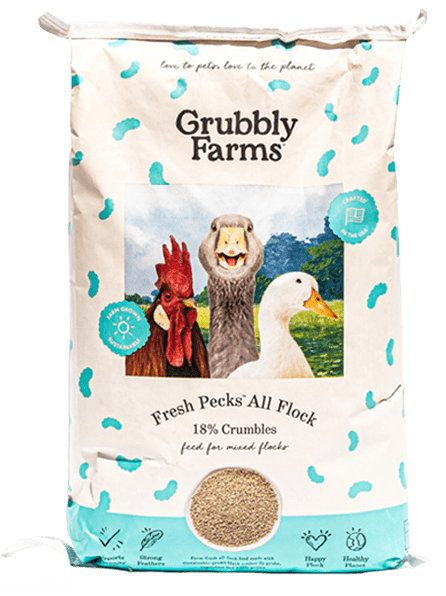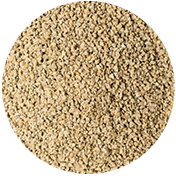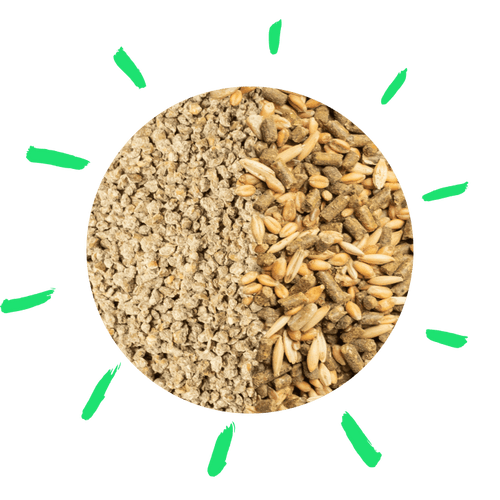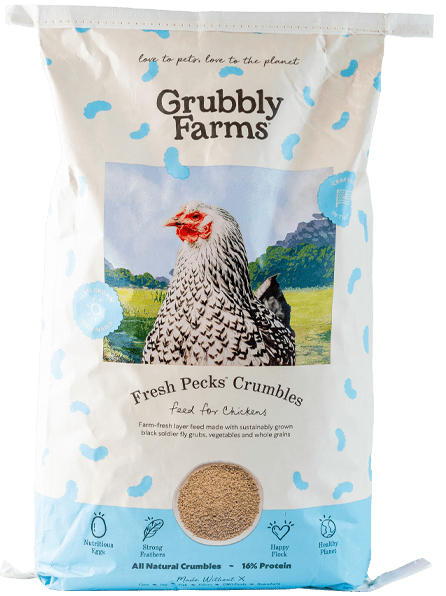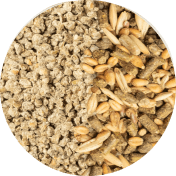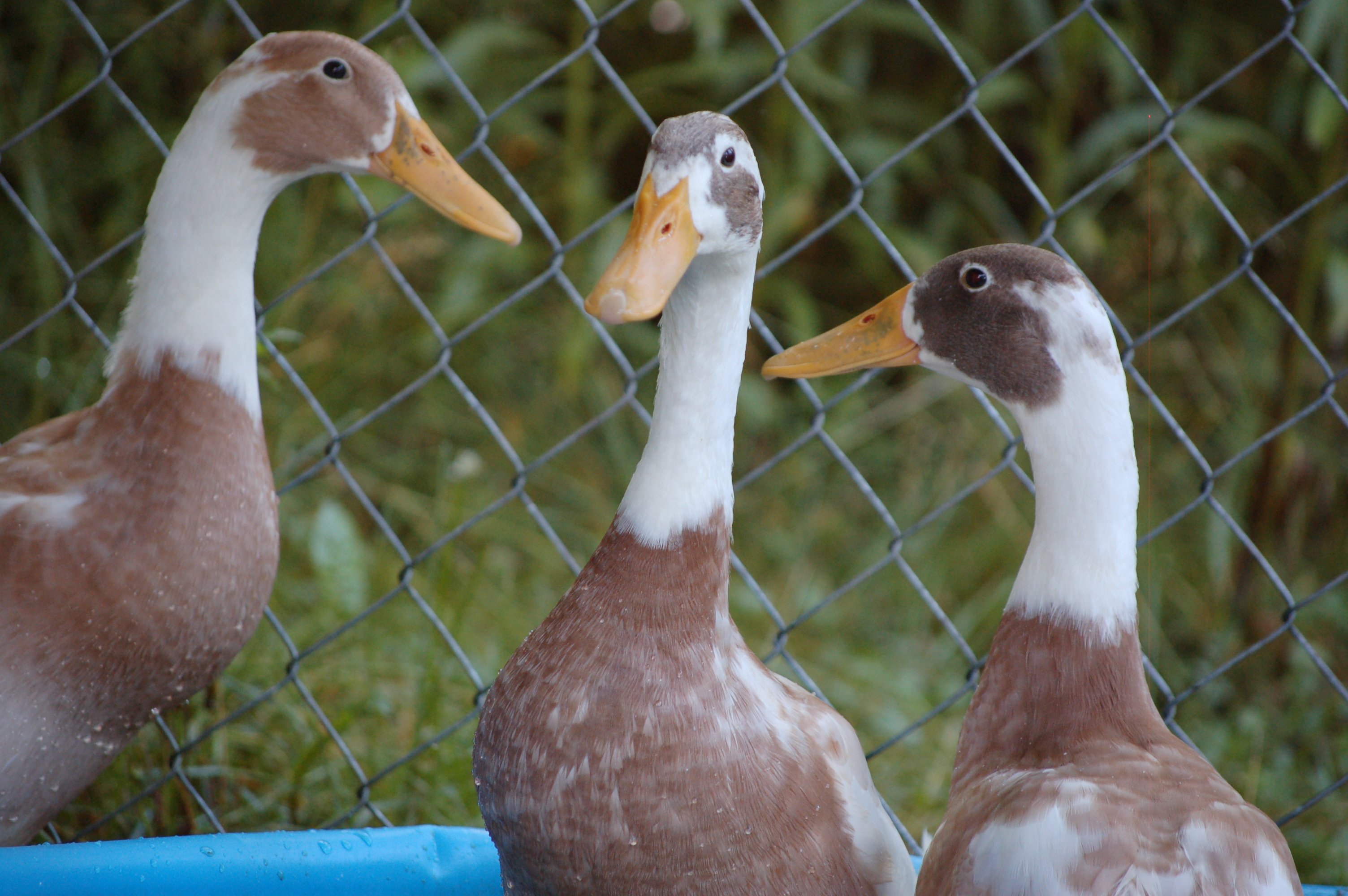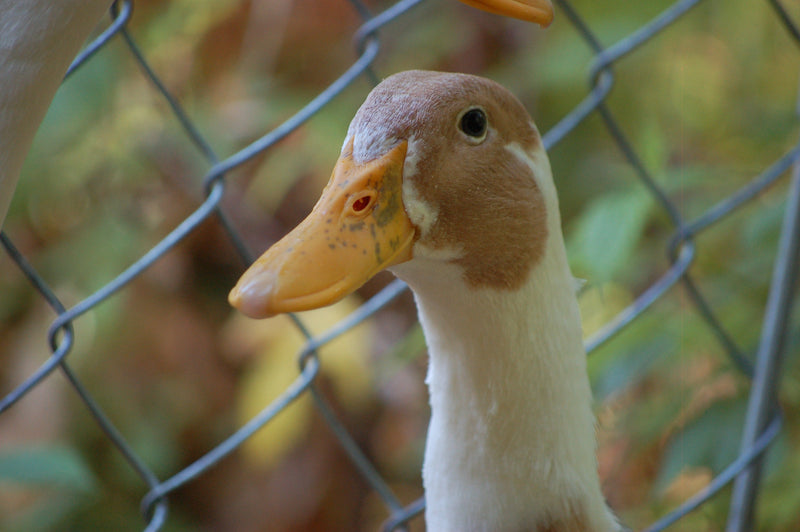Duck, duck... chicken? Goose? Guinea? They say birds of a feather flock together, but is it okay for birds of a different feather to be raised together? Raising a mixed flock can add variety and uniqueness to your backyard. However, each poultry species has its own special care needs. A coop designed for chickens may not work the best for turkeys, or quail, or guineas. Learning the care needs of each poultry species, like turkeys, guineas, ducks, geese, quail, and guineas can help you figure out if keeping a mixed flock is right for you!

Best Birds to Raise with Chickens
Each species of poultry has its own care needs, which is why it’s often beneficial for each species to have their own coop. A mixed flock can often forage together and share the same yard during the day! The best practice for raising multiple poultry species is to house each species in their own coops but allow everyone to free-range together in the same yard. However, ducks, geese, turkeys, and guineas can all be housed with chickens as long as some coop modifications are done to accommodate the different species.
Quail are the one exception as they should not be housed with chickens.
We’ll go into detail on how each of these impacts care for specific birds, but the here are the core components to consider when housing different poultry species together in the same coop:
- Roosting bar height
- Nesting needs
- Coop space
- Proper feeders and water sources
- Additional open water source for waterfowl
When it comes to raising different poultry species as babies, only keets (young guineas) and chicks can safely share a brooder. Ducklings and goslings make the brooder too wet for young chicks. Poults (young turkeys) are much larger than small chicks and can be accidentally dangerous to the fragile chicks.

Raising Quail with Chickens
Housing Tips
Just like for chickens, quail need covered and protected housing in order to keep them safe from predators. However, quail also need housing that will keep them completely contained and prevent them from going back to the wild. Raising quail is tricky since they are not as domesticated as chickens and will quickly revert to self-sufficiency if they are let loose.
This means quail do not free-range well. They are not as easy as chickens to coop train, but they can be taught to return to their housing with some persistent and careful training.
Chickens and quail should not be housed together. Chickens are so much bigger than quail that the quail may get bullied by the bigger chickens. The quail may not be able to get food or water and may be harassed by the chickens. Chickens will also find quail eggs a tasty little snack, which can lead to the bad habit of egg eating. Instead, we recommend keeping quail in their own housing.
A quail coop does not need to be as big as a chicken coop since quail are so much smaller. A quail coop should supply at least 1 square foot of floor space per bird. It’s also important to provide access to an enclosed outdoor pen that give the quail as much run space as possible. Quail spend a majority of their time on the ground, much like chickens, and they benefit from having an enriched enclosure that mimics their natural habitat as much as possible. Branches, logs, leafy cover, shrubs, grass, and leaves can keep your quail happy even in a confined environment.
Feeding Quail
It is difficult to raise quail and chickens together outside of just their size differences. Chickens are omnivores, meaning they eat a variety of foods including grains, seeds, bugs, fruits, and leafy greens. Quail are granivores, which means their diet consists primarily of seeds and grains. In the wild, quail will sometimes munch on berries and an occasional insect or two, but only when foraging for grains and seeds gets scarce.
Quail raised in captivity should be fed a gamebird feed consisting of various seeds and grains that are small enough for quail to eat. Quail will instinctively peck through their feed and eat the grains and seeds that they need.
If quail and chickens are raised together, it would be hard to keep the chickens from eating the quail feed. While quail feed is not bad for chickens, it would take away from the nutrition that the chickens should be receiving from their own feed. Laying hens would not get the proper nutrition they need if they consumed a diet of mostly quail feed.
Like all birds, quail also need a source of drinking water. Both the water source and the feeder should be at ground level so that the quail can easily access the feed and water. Chickens benefit from raised water and feed systems, which would be difficult for quail to access.
Disease
One major reason for keeping chickens and quail separate from each other is due to the transmission of diseases. A disease that is a minor inconvenience for a chicken can be deadly for small quail. Coryza is one disease that chickens can give to quail. For chickens, Coryza can be successfully treated with antibiotics, however, the chicken will remain a carrier of that disease for the rest of its life. When spread to quail, Coryza is often deadly for smaller birds before a treatment can be successfully administered.
Even though disease can be spread between the two poultry species, chickens and quail can be successfully raised on the same property together. It is just not ideal to keep both chickens and quail close to each other in housing. In general, keep the quail and chickens housed at least 50 feet apart to prevent disease transmission.
Raising Turkeys with Chickens
Housing Tips
After discussing one of the smallest poultry species you can add to your backyard, let’s take a look at one of the bigger poultry species... turkeys! Turkeys are closer to chickens when it comes to care needs and basic housing. However, turkeys are much larger than chickens, so their housing will need to be scaled up properly!
Turkeys and chickens can be safely housed together, however, some coop modifications may need to be done in order to accommodate the larger birds. In general, keeping turkeys in their own separate coop is ideal so that they can be fed a higher protein diet and their coop can accommodate their larger size.
A turkey coop should provide at least 6 square feet of space per turkey and at least twice as much enclosure space. Turkeys do well with a free-range lifestyle, which can be more practical than keeping them in a large fenced in enclosure. A turkey coop should also have wider roosting bars, a larger door for the turkeys to access the coop, and large nesting boxes.
Roosting bars for turkeys should be wide enough to make it easy for the large-footed birds to balance on the roosts. Even though turkeys are large in size, they do like to roost up high. Turkey roosts should be at least 6 feet off the ground as a turkey’s instinct is to roost up high.
The door on the turkey coop needs to be big enough for the turkeys to fit through and at no more than 6” above ground level. While turkey hens may not always choose to use a nesting box, large nesting boxes should be provided, nonetheless. In general, turkey nesting boxes should measure 24”x24”x18” in size and you should supply 1 nesting box per every 4 turkey hens housed in the coop.
Feeding Turkeys
One reason why chickens and turkeys can be housed together (as long as coop modifications are considered) is because they can eat a similar diet. Turkeys can be fed layer feed with no ill effects. However, it also helps to supplement their diet with extra protein snacks or give them the opportunity to free-range to supplement their diet on their own. If you are raising your turkeys for meat, you will want to feed them a high protein gamebird feed that will supply the turkeys with energy and protein they need to reach butchering weight.
The feed and water sources for chickens and turkeys should be at the appropriate height so that even the shorter chickens can reach the food and water. If you are feeding the turkeys a high protein gamebird feed, it can sometimes work to keep the feeder up higher off the ground so that only the turkeys can easily eat from their feeder.
Disease
Chickens and turkeys share similar diseases. One disease that chickens can spread to turkeys is Blackhead disease. Chickens are often asymptomatic when they have Blackhead, but they can spread the deadly disease to turkeys. Raising chickens and turkeys together can be tricky in areas where Blackhead disease is more prevalent, such as warm and humid climates.
General Management
When raising chickens and turkeys together, there are just a few general management things to keep in mind. First, turkeys are not as domesticated as chickens. When given the opportunity to free-range, turkeys are more prone to wander unless they are coop trained. Even when trained, turkeys will often take to roosting in the trees at night instead of in a coop.
If you fence in your turkeys, they need taller and sturdier fencing compared to chickens. Their bigger size, taller frames, and heavier weight can make it easier for them to get over flimsy fencing that is sufficient to keep chickens contained.
You will also need to consider flock dynamics if you get a tom (male) turkey. When raised with chickens, tom turkeys can usually peacefully coexist with both hens and roosters. However, you will want to keep an eye on your tom during mating season. Sometimes tom turkeys will go after hen chickens, which can be dangerous for the smaller birds. You will need to separate your tom turkey if he gets too assertive towards the chickens during mating season.
One benefit to keeping chickens and turkeys together is that turkeys will sometimes act as guard animals. Especially tom turkeys, who may take protecting their mixed flock very seriously.

Raising Guinea Fowl with Chickens
Housing Tips
Another unique poultry that can be fun to add to a mixed flock are guinea fowl. Chickens and guinea fowl can be raised and housed together, however, guinea fowl are much more independent than chickens. Coop training guinea fowl will take patience and persistence, and even then, guineas much prefer to be left to their own devices. In a nutshell, when housed together, guineas and chickens will often ignore each other.
It is best to raise guinea fowl in the coop where they will be kept for the rest of their life. This will help reduce the risk of your guineas wandering off when allowed to free-range. Adult guinea fowl will often try to return to the place where they were raised if they are brought to a new coop.
Given their self-sufficient and independent nature, guinea fowl may or may not share a coop with chickens. When allowed to free-range, guineas will often roost in trees or barn rafters rather than returning to a coop at night. If kept confined, make sure the guineas have plenty of covered space to prevent them from flying out.
Guinea hens won’t nest in nesting boxes. They will usually choose their own nests and all the guinea hens will usually lay in the same nest. Guinea hens will also share the responsibility of incubating a clutch of eggs.
Feeding Guineas
Guineas and chickens will eat a similar diet. Guinea fowl can be fed a regular layer feed or all flock feed, however, if given the opportunity to free-range, guinea fowl will forage for a majority of their own diet. Since guinea fowl are so independent and wild by nature, it can sometimes be beneficial to raise keets (young guinea fowl) with chicks in the same brooder. The chicks can be a good influence on the keets and instill a flock mentality.
Young keets need to be fed a gamebird or turkey starter feed high in protein (21-23% protein) for the first 4 weeks of their life. The higher protein feed is not dangerous for the chicks. After 4 weeks, you can switch both the keets and the chicks to a high protein chick starter feed (18% protein) until both reach 20-21 weeks of age. Then switch to a layer feed.
It is helpful to keep your guinea’s food and water source close to their coop to help with coop training. Even though the guineas will forage for a majority of their diet, they may still return to the coop for free food and to get water. When raising guineas and chickens together, the food and water sources should be accessible to both species.
Disease
Chickens and guineas share similar diseases. Guinea fowl are much hardier than chickens and are often resistant to many diseases that plague chickens. With that being said, guineas are more prone to be picked off by predators since they like to wander.
General Management
Since chickens and guinea fowl can be raised together in a mixed flock, you should know a few general management tips about keeping these two species together. First, you will find that guinea fowl are very different from chickens. They have been minimally domesticated and do not need humans to survive on their own.
Even though it can be helpful to contain guinea fowl by keeping them confined, guineas really do not thrive in a confined environment. They do much better when they are allowed to free-range. Once the guineas learn where their home range is, they will often stay within the vicinity of where they were raised. When teaching your guineas to free-range close to home, you must do so gradually and at a young age.
Once the keets are old enough to be without supplemental heat and fend for themselves, start by letting one keet out to free-range. The single keet won’t want to stray far from the other keets who are still confined. On the second day, let out two keets and subsequently let out one more keet each day. This can help imprint their home territory and prevent roaming off if they were let out all at once.
To further help with coop training, it’s helpful to install a small night light where you want them to roost. Guineas don’t like entering dark places to roost, a small light can encourage them to return to their roosts as night. Cracked grains and treats can also help entice your guineas back to their coop, although you may find that your guineas could care less about any food you provide for them.
Guinea fowl behavior is also slightly different from chickens. Since they are a very wild species of poultry, guinea fowl make great guard animals. They can be protective of their territory and will make loud alarm calls when something startles them. Their loud noises may startle you and your chickens at first!
Male guineas can also be aggressive towards rooster and smaller chickens. Make sure your male guinea fowl has at least 5 female guineas to keep track of. This will minimize his attraction towards the chickens. You may need to separate your male guinea if he gets too assertive. Raising the guineas with your chickens can also help them accept the chickens as a natural part of their environment and not something to be protective against.
Raising Geese with Chickens
Housing Tips
Geese differ from quail and turkeys by the fact that they are a waterfowl poultry species. Geese can be housed with chickens, but young goslings cannot be raised with chicks. While it is okay for geese to share the same coop as your flock of chickens, the coop may need some modifications to accommodate the geese.
Geese don’t roost on perches and they rarely use nesting boxes. Instead, you should have a thick layer of soft litter, like straw, on the floor of the coop. Geese will nest down in the straw at night and will also lay their eggs in straw nests. They are bigger birds than most chickens, so the chicken door will need to be big enough for the geese to come in and out of the coop through. It also needs to be close to ground level since geese can’t go up and down ramps very well.
Geese need a minimum of 5-8 square feet of coop space per goose and at least 20 square feet of outdoor space per goose. Make sure you plan your coop size accordingly if you plan on adding geese to your flock! Allowing your geese to free-range can be a great way to ensure they have plenty of outdoor space.
Geese can be kept confined, however, they still need plenty of outdoor space and access to an open water source for bathing. Keeping chickens and geese in the same coop can be done, but it may be more practical for the geese to have their own coop. The geese and the chickens can free-range together and share the same yard, they will each go to their own coops at night.
Feeding Geese
Another reason why you might choose to have a goose coop rather than housing the geese with your chickens is because of dietary needs. Geese can consume layer feed, but they thrive better on a waterfowl feed that contains the proper protein and niacin content needed by waterfowl.
If you are feeding your geese and chickens separate feeds, it may be helpful to keep each bird’s feeder inside their coops. First off, geese need a shallow feeder for their wide bills. It may be hard to keep your chickens from learning where they can snack on the waterfowl feed, but keeping the feeders in separate locations can help.
Chickens and geese can both eat similar treats and healthy snacks!
Water Needs
One big difference between raising chickens and raising waterfowl is the fact that waterfowl need an open water source. Not only do they need drinking water, but they also enjoy a water source to swim, splash, and bathe in. If you have a pond on your property, you will find your geese will spend a majority of their time in or around the pond.
If you don’t have a pond for your geese, you will want to provide them with a pool that is big enough to fit several geese in at one time. Swimming is a community activity for geese! If you have to confine your geese, make sure the geese still have access to an open water source. Your chickens should have access to a separate pen without an open water source so that their enclosure stays dry. However, a wet environment can harbor diseases that are dangerous for chickens.
Both your chickens and your geese should have access to fresh, clean drinking water every day. Make sure the geese can fit their wide bills into the water source, although, they may just choose to drink from their open water source instead.
Disease
Chickens and geese share similar diseases and ailments. The biggest health concern is the wet environment often created by the geese. Chickens need a dry coop and enclosure in order to stay healthy so plan accordingly.
General Management
Keeping chickens and geese together in a free-range environment is ideal for both species. By ensuring that both the chickens and the geese have plenty of space, you can minimize any bullying that might occur between the species. Make sure you follow proper integration methods when introducing geese to your flock so that the geese learn not to be protective against the chickens.
Geese can make great guardian animals for your flock! They will often defend their territory and alarm you when a predator is nearby. Even though geese love to free-range, they can be more destructive to landscaping and more prone to wander if they are not coop trained. Having an open water source close to the goose house can help the geese learn where their boundaries are without wandering too far from their coop.

Raising Ducks with Chickens
Housing Tips
Another waterfowl species you may consider adding to your mixed flock are ducks! Ducks are very similar to geese when it comes to raising them with chickens. Ducklings cannot be raised with chicks since they make the brooder too wet for young chicks. However, adult ducks can be housed with chickens as long as some coop modifications are done.
Like geese, ducks will not roost on roosting bars and will usually not use nesting boxes. The coop needs to have a thick layer of soft litter on the floor so the ducks can nest into the litter at night. You can encourage your ducks to lay their eggs in nesting boxes by providing large nesting boxes that are at ground level, however, a lot of times the ducks will just choose their own spots to make a nest and lay their eggs in the litter.
Whether you are housing your ducks with your chickens or keeping them in a separate duck house, you need to make sure there is plenty of space for the ducks. Ducks need a minimum of about 4 square feet of coop space per duck. More space will be needed by larger duck breeds. They need a minimum of about 8 square feet of enclosure space along with access to an open water source.
Feeding Ducks
Like geese, ducks can be fed a chicken layer feed or all flock poultry feed. For both ducks and geese, it is a good idea to supplement the layer feed with a niacin supplement (like Brewer’s yeast) and to give them healthy, high protein snacks. However, ducks do best on a waterfowl feed that contains the proper protein and niacin for waterfowl.
Ducks need a feeder system that can fit their bills and that is located somewhat near their water. Ducks need to have access to water in order to help them swallow their food and keep their nasal passages clear. If you are housing your ducks and chickens in separate coops, keep each species’ feed in their own coop to encourage them to consume the correct diet.
Chickens and ducks can enjoy the same treats and healthy snacks!
Water Needs
Since ducks are a waterfowl species, they benefit from having access to an open water source, whether that be a pond or a manmade pool. If you use a pool that is dug into the ground, keep in mind that your chickens will be able to access the water too. Above ground pools will make it so that only the ducks can get in the pool. Whatever pool system you use, you will want to be able to drain and refill the pool every day so that the water doesn’t get too disgusting.
Make sure your chickens have access to a dry enclosure separate from the ducks' water source so that they can dust bath and stay away from the wet environment. You will also want to keep your ducks’ drinking water system outside of their coop so that they don’t make a wet mess inside their coop.
Disease
Chickens and ducks share similar diseases. Again, the biggest concern with raising waterfowl with chickens is the wet environment often created by waterfowl. Make sure your chickens always have access to a dry coop and enclosure so that they can stay away from muddy conditions which can harbor disease and parasites.
General Management
The biggest management concern to be aware of when raising chickens and ducks together is managing roosters and drakes (male ducks). If integrated properly, roosters and drakes can co-exist as long as each one has the proper number of hens to control. Problems may arise during mating season when drake ducks are trying to assert themselves.
It is a good idea to have a rooster in your mixed flock to prevent the drakes from harassing the female chickens. Drakes will sometimes try to mate with hen chickens and in the process end up drowning the hen when they try to mate with her in the water. You can avoid mating issues by keeping your drakes separate during breeding season or having an assertive rooster who will protect his hens from the ducks.
Conclusion:
Turkeys, geese, ducks, guineas, quail, and chickens each have their own dietary needs and housing considerations. While raising different poultry species in the same coop may not be practical, that's not to say birds of a different feather can't share the same backyard, homestead, farm, or pasture! Having a free-range mixed flock is one of the easiest ways to raise multiple poultry species together. Many poultry species can coexist peacefully together in the same space so you can enjoy endless hours of entertainment, a variety of fresh eggs, and the uniqueness of each bird in your mixed flock!





